Arguably one of the oldest tools known to humanity is the hammer. The irony is that we’re still trying to come up with new ways to improve it! While it might be a prehistoric tool, it’s unlikely to go extinct any time soon since most homes (at least in the USA) are still constructed out of wood. While the best nail guns take a lot of the work out of driving nails, you still find a hammer slung from the hip of any framing contractor. For this reason, we looked at many of the current hammers on the market to select the best framing hammer.
The Best Framing Hammer – A Key Tool
In the years I’ve done construction, I’ve found many strong opinions on hammers. Actually, now that I think about it, hammers could be one of the most polarizing tools I’ve encountered. Everyone has their opinions on what makes a good hammer. Steel, wood, or fiberglass handle? Titanium or steel head? Straight or curved handle? Smooth or textured grip? In full disclosure, even I have to admit some bias. My framing hammer of choice for the last several years has been a Douglas 20 oz framer. This hammer is great because of the genius head to handle connection, the straight, chisel-tipped ripping claw, and the side nail puller. The fit and finish are second to none, and there is a certain balance that I appreciate. It is a beautiful blend of function and form. But is it the very best hammer? That’s a very good question. I’d like to find out.
Although I had some favorites, that’s not to completely diminish the other hammers in our lineup. Some of them definitely had some great qualities worth mentioning. Following are our recommendations on the best framing hammer for various applications.
Best Framing Hammer Overall
Stiletto Ti16MC 16 oz.

The claim to fame of the Stiletto Ti16MS framing hammer is its 16 oz. titanium head. This head, combined with a straight hickory handle, was the overall lightest hammer in the lineup. However, it still weighed more than the Stiletto 12 oz Titanium Remodeler hammer. The head is very classic in its style with a large strike face and deep milling.
There is a magnetic nail holder on the top of the head. At the base where the handle is inserted into the head, there is about a 3/4-inch extension of extra metal. This provides some strike protection to the handle. Quite simply, this hammer is a joy to swing, and over time your arm, shoulder, and elbow will thank you. While the $107 retail price tag is the second most expensive in the test, you can find it online for far less. And really, if you’re swinging a hammer all day long, I’m not sure you can put a price on comfort.
Pros: Lightest hammer in the test, Second largest strike face.
Cons: Cost.
Verdict: The heavy-hitter with the lightest swing.
Price: $99.99
Best Framing Hammer for Demolition
DeWalt DWHT51411 17 oz.

While I’m normally a fan of DeWalt tools, this hammer frustrated me. The thing that got to me was the oddly-angled head. What I found is that it never seemed to swing with the feel of a traditional hammer—often striking unevenly. Still, we loved the “Fubar”-like design that grips and twists 2x4s effectly when using a nailer (in your other hand) to secure studs. We also loved the integrated side nail puller.
Pros: Low price, nail puller.
Cons: Odd swing, no nail magnet.
Verdict: While it swings well and hits hard, the sticky coating on this handle will likely drive you nuts.
Price: $37.99
Best Wood-Handled Framer
Vaughan & Bushnell 2115C Dalluge 21 oz. Framing Hammer

The Vaughan & Bushnell 2115C Dalluge Framing Hammer features a 21-ounce waffled head. As a framing hammer, we love the simple design. The 18-inch hickory handle feels great in the hand and gives you a comfortable swing. The steel head also features a magnetic nail holder. Of all the hammers tested, this tool felt most like the quintessential framer.
Pros: Magnetic nail puller, comfortable swing
Cons: None
Verdict: If you want a traditional “no-frills” framing hammer, it doesn’t get better than this.
Price: $65
Dead On Tools 24oz Investment Cast Wood Hammer
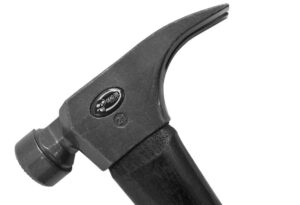
We’d call this one a runner-up. This 24-ounce hammer really felt easy to swing—despite its weight. From the black wood handle to the milled face, the Dead On Tools 24oz investment cast wood hammer means business.
We like the magnetic nail set and the confident straight black hickory handle. The hammer measures a full 18-inches from top to tail and it swings very naturally with excellent overall balance. If you’re all about the look this may be your tool!
Pros: Excellent balance, inexpensive.
Cons: No frills, non-replaceable head.
Verdict: This hammer is cool, but it’s not titanium and might have difficulty keeping its good looks.
Price: $99
Best Steel Framing Hammers
DeWalt MIG Weld Framing Hammers
Coming to market with a metal-handled hammer proves tricky since other well-established tools already exist. Where the DeWalt MIG weld framing hammer differs from others is its construction methods. Rather than a single forged handle and head, DeWalt uses three separate steel forges that it then mig welds together.
DeWalt does this so that it can heat treat each of the pieces differently. Combined, the hammer has good wear, toughness, and flexibility in all the right places. All in all, this hammer is comfortable to use. It exhibited decent balance as well. You can find these in sizes ranging from 12 to 15 ounces.
Pros: Light head with a large strike face, Attractive, Easy to swing, Size options.
Cons: Transfers more vibration than a wood-handle hammer.
Verdict: A heavy hammer that swings lighter than you might expect.
Price: $54
Douglas FR-20S or DFR-20S 20 oz.
This Douglas hammer was a gift to me from my brother who is a framing contractor in Alaska. He promised me that this hammer would become one of my favorite tools because of its balance, design, and features. He was completely right, as I’ve used this tool more than any other over the last 5 years since he gifted it to me. This hammer has a genius handle-to-head attachment system that is not only rigid but also provides handle overstrike protection.
Because of how it’s designed, it features one of the easiest-to-replace handles in the industry. The face features inverted dimples which help grip nails still but don’t mar delicate materials, and its built-in side nail pull and almost ruler-straight claw make it easy to do demo and disassembly work. This handle is relatively unchanged throughout the years except that the new model features an attractive red accent color. Unfortunately, Douglas cannot seem to keep this tool in stock. Neither can Vaughan who makes the similar (but titanium) 7180 Dalluge. If you can find one—buy it!
Pros: Stainless steel head, Excellent balance, Great fit and finish.
Cons: Cost and availability (they cannot seem to keep items in stock).
Verdict: In my opinion, this is the hammer to beat.
Price: Vaughan & Bushnell 7282 for $99
Best Titanium Framing Hammer
Stiletto TB3MC 15 oz Ti-Bone titanium hammer

I know we chose the hickory 16-ounce model as our top overall, but this model is titanium through-and-through. This 15-ounce hammer dates back to the beginning of the Stiletto brand. The Stiletto Ti-Bone III titanium hammer features a milled face (they have smooth as well) and an integrated 180º side nail-puller. The TB3MC hammer stands as one of my top four favorites out of the models I looked at.
It really drives hard—like a much heavier steel hammer. I’d put it around 24 ounces or higher if you want a comparison. The hammer features a removable steel face so you can purchase replacement heads (smooth or milled) without having to buy a whole new tool. It also gives you the strength of that steel hit with the weight of a titanium hammer.
It also featured titanium all the way through the hammer—not just at the head. The rubberized grip on the handle gives you a secure hold and doesn’t seem like it will peel or crack. We also love the well-placed thumb indent at the top of the coated handle.
Pros: Great price, Classic look, Nice balance.
Cons: Nothing to complain about here.
Verdict: One of my favorite hammers, and one of the best-looking in the crowd.
Price: Check out the 16oz titanium equivalent for $99
Best Budget Framing Hammer
Dead On 24 oz. Milled Face Straight Hickory Hammer
Dead On used to call this hammer the “Death Stick”. That inherently makes it cool (though not necessarily good). The steel head measures 24 ounces and includes a built-in magnetic nail set. You get a black curved hickory handle. This hammer falls in the middle for overall weight yet it had a balanced feel when swung.
The face of the hammer is not as aggressively textured as I like since it was investment cast and not finish machined. The strike face size is also the second smallest out of the hammers that I looked at. Finally, Dead On heat-treated the face area and claws to maximize life. You can find cheaper hammers, but for the price, we like this as our budget pick.
Pros: Cool name.
Cons: Smaller strike face, not very aggressively textured
Verdict: An aptly named tool whose name and look might be a bigger hit than the actual hammer.
Price: $34
Best Made in the USA Framing Hammers
Hardcore Hammers The Original 19 oz.
The idea behind The Original is certainly innovative. By slightly recessing the waffle, face wear by striking anything other than the nail is pretty much eliminated. However, the area surrounding the face is larger than I would like, so strikes anywhere other than near the dead center of the face are potentially nail-bending shots. Because of the face, it seemed to take an extra whack to really set nail heads flush with the wood. This tended to leave a decent circle imprint around the nail.
We did like the dual nail magnets on the top and bottom of the face. Hardcore Hammers also makes these tools in the USA.
Pros: Double nail magnets, lightweight steel head, hardened steel waffle face.
Cons: Small strike face area, Glancing blows tend to more easily bend the heads of nails.
Verdict: A hammer with a great idea that could use some tweaking.
Price: $105
Vaughan California Framer 19 oz.
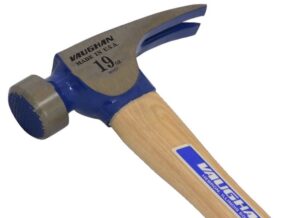
The Vaughan California Framer 19 oz hammer has classic styling and size. If you like to wield a full-size hammer that hits hard, this American-made classic isn’t just a good choice—it’s a good value as well. I picked this hammer as one of my top four selections in this line-up.
Pros: Heavy head hits hard, No surprises.
Cons: Not much to complain about.
Verdict: This classic-style hammer hits hard and drives nails home as you’d expect.
Price: $46
Estwing Big Blue 25 oz.
This metal-handled Estwing hammer is probably the most identifiable out of our test. Time and time again I have seen these hammers beat to heck with faces worn smooth from use. Unlike wood-handled hammers, these metal Estwing tools have the distinction of being nearly indestructible. Perhaps that’s what makes them great for pulling nails and heavy-duty prying in addition to their nail-driving abilities.
While this hammer was the heaviest in our test, it still displayed good balance. The USA-made Estwing line of metal-handled hammers sits in my top four hammers list simply because of their durability and balance.
Pros: One piece handle and head, Reasonable price, Nice finish.
Cons: Nothing negative to note.
Verdict: This hammer is practically a staple tool in most contractors’ pouches and bags. It’s not perfect, but it gets the job done.
Price: $49
So What Makes for the Best Framing Hammer?
To better understand some hammer technology (yes, there actually is technology involved), it makes sense to have a quick science lesson on the physics of a hammer.
Don’t worry, this won’t hurt much.
How Mass Plays a Role – WARNING: Math Ahead!
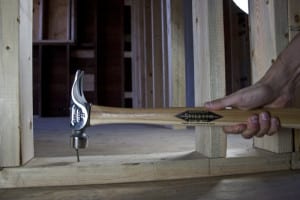
A hammer is a force amplifier that converts mechanical work into kinetic energy and back again. When swinging a hammer, kinetic energy gets stored in the hammer’s head. The kinetic energy equals the length of the swing times the force produced by your muscles (and gravity). When the hammer strikes the nail, the nail stops the head with an equal and opposite force.
Where this gets tricky is when you start to take into consideration the effect of the mass of the hammer’s head. The amount of energy delivered to the nail by the hammer is equal to one-half the mass of the head times the square of the head’s speed at the time of impact. The key here is that the energy delivered to the nail increases linearly with mass but it increases quadratically with the speed.
KE = 1/2 mv2
Let me summarize that for you: An easier-to-swing hammer delivers more energy to the nail. This forms one of the key arguments in the titanium hammers vs steel hammers debate.
Hammer Handles Matter Too
Lightweight hammer heads allow for faster swing velocity, but handle designs can also help the efficiency of your swing. That includes taking into account vibration-absorbing materials, length, and angle. Essentially, to find the best framing hammer, it will have to have a combination of certain head and handle qualities that make it feel “right”.
There are literally hundreds of hammers out there, so for the sake of time and practicality, we tried to limit the playing field to framing hammers whose head weights ranged in the low to mid 20 ounces, had long handles, straight rip claws and milled faces. Both titanium and steel models were acceptable. Our list of hammers is in no way inclusive of all that is available. There are many more manufacturers and models that I did not get a chance to put my hands on yet. Perhaps I’ll have to revisit this after I collect and evaluate all of the hate mail I’m sure to get following this best framing hammer review. (I did mention this was a contentious topic, did I not?)
Measuring and Weighing the Best Framing Hammers
I started out by weighing each hammer. Then I measured the face size using calipers, handle length with a tape measure and set up a grid to make comparing and evaluating the various tools easier. When I measured the face, I didn’t use the outer diameter of the head, but rather the area of the milled surface. In almost every hammer that space is smaller than the head’s full outer diameter. I figured it was more important to know the actual striking area of the hammer as opposed to the full head size.
It is also interesting to note that while some hammers might have a lightweight head, the handles sometimes added back enough weight to counteract any gains achieved in shaving off some extra steel. We point this out because a hammer’s weight is more than just the head. It’s the entire hammer (a number manufacturers do not always prominently advertise).
Manually Testing the Framing Hammers
I tested out each hammer with both bright and galvanized 16 penny (16D) nails. I drove the nails into spruce studs and some pressure-treated 4x4s. Since so much of a hammer’s function is dependent on the skill and technique of the user, extensive testing really is not necessary for the scope of this article. In other words—I didn’t have to drive in thousands of nails before drawing some conclusions.
In fact, I took lots of breaks so that I wouldn’t be swayed by a tired arm or a sore wrist. Perhaps in the future, when time and budget permit, I can develop a piece of scientific equipment to analyze things like striking force, vibration, and swing efficiency. While it would be cool to have statistics on these variables, this is ultimately a subjective topic requiring a subjective review.
Reviewing hammers is just like reviewing trucks. Some Pros are polarized on which brand they like. You can test, re-test, and crown a winning truck of the year (every year). Everyone still has their personal preference on what pickup they want to drive.
Maybe the best hammer test would have all of the participants blindfolded and I could hand them a random hammer to see what they really think. While they wouldn’t be swayed by brands, colors, materials, and logos, it might be one of the more painful tests we’ve ever run!

Value, Features, and Performance
After spending some time with all of the hammers I ended up with this list of what I felt were the best. I based this on their value, features, and overall perception of their performance. Of course, nearly any framing hammer will drive a nail. However, not all of them will do it well. In addition to my beloved “benchmark” Douglas framing hammer, I tested steel and titanium selections from Stiletto, Estwing, DeWalt, Vaughan, and others. I also looked at a cross-section of synthetic, steel, and wood handles.
In the same way that I prefer Ford trucks, I might also display a slight bent towards more traditional hammers. This entire experience remains largely subjective.
While I may prefer particular features, the best test of a hammer is picking one up and taking a swing!
Why You Can Trust Pro Tool Reviews
Ever check out a “review” site and you can’t tell if they actually tested the tools or if they’re just “recommending” the Amazon top sellers? That’s not us. We won’t recommend anything unless we’d actually use it ourselves and we don’t really care who the primary retailer is. It’s all about giving you a legitimate recommendation and our honest opinion of each product.
We’ve been in business since 2008 covering tools, writing reviews, and reporting on industry news in the construction, automotive, and lawn care industries. Our Pro reviewers work in the trades and have the skills and experience to know whether tools can perform well in the field.
Each year, we bring in and review more than 250 individual products. Our team will put our hands on hundreds of additional tools at media events and trade shows throughout the year.

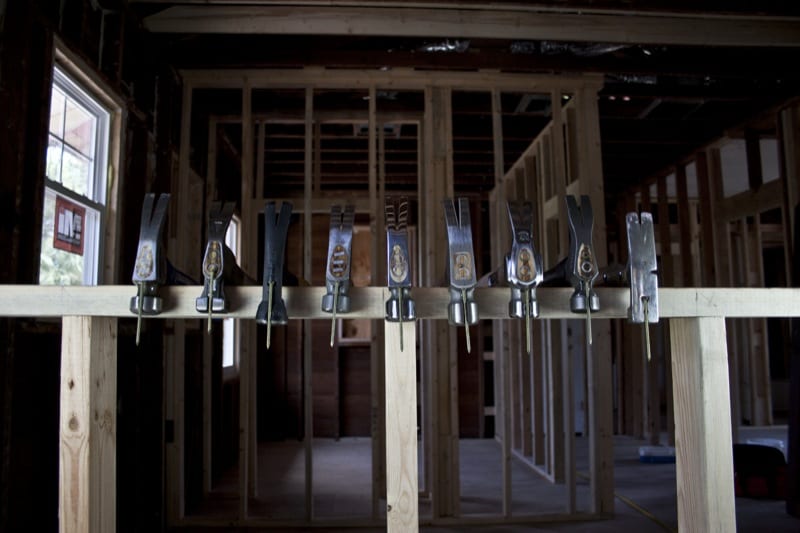

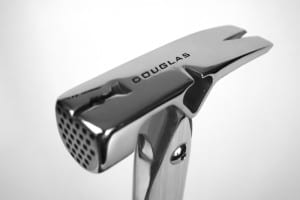

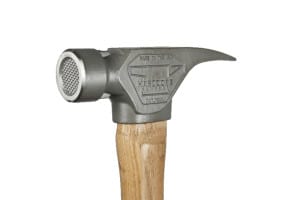
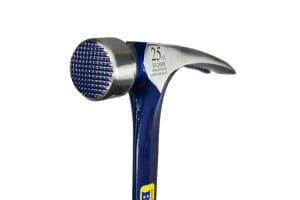




Same Martinez is my #1 pick why no mention of them in the artical? Considering he did also invented the stiletto. I guess since he doesn’t pay to get his product into the mags they always leave out their awesome hammers. Yeah they are expensive but you get what you pay for. Plus if your someone that needs to be convinced why they should try and or buy a high end hammer then most likely they will not see the reason and why waste your time trying to?
Martinez
Curious about thoughts on an Estwing with a hammertooth for those twisted 2x4s. https://amzn.to/30eZVx8
When i first started framing i bought a vaughan calif framer with a curved handle probably cause i thought it looked coolest. I show up to work and by boss grabbed the hammer and said whats this you brought your grandmas sewing hammer? Haha.. then threw it across the job site. When i went to go get it he snatched my fatmax xtreme tape and threw it and said come back with real tools. Now i know but i got this hammer i really liked and havent found one as comfortable ever since.. It was a 19 ounce blue max… Read more »
I always wanted a really good hammer so I went out and purchased a Hart Hammer 5- 6 years ago. The rubber end piece on the handles fell off about 18 months ago. I recently took it back to Bunnings who showed it to the sales rep who said it was not cover by the limited life time warranty as I don’t have the receipt. I purchased what I thought was a really good hammer that was going to last me a life time and I am a home handy man so not even using it that often. What a… Read more »